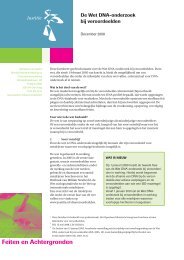INTERPOL HANDBOOK ON DNA DATA EXCHANGE AND PRACTICE
INTERPOL HANDBOOK ON DNA DATA EXCHANGE AND PRACTICE
INTERPOL HANDBOOK ON DNA DATA EXCHANGE AND PRACTICE
Create successful ePaper yourself
Turn your PDF publications into a flip-book with our unique Google optimized e-Paper software.
• Each item should be packaged, sealed, and labelled as soon as it is taken.• Never pack several items/objects together.• Use bags of a suitable size or shape, do not force items into packaging that is toosmall, bags may tear or lids may be forced off.• Seal all packaging securely; use adhesive tape on all edges and sign and date over seals.• Never use staples or pins to seal packages.• Never re-use packaging.• If an item will not fit or packaging is used in error do not use it for a different item.It must be discarded.• Never eat, drink or smoke when recovering evidential samples.•conditions for storing the samples• Dry samples should be kept at room temperature (cool if possible) and out ofdirect sunlight. Dry samples stored at ambient temperature should not deteriorate/decompose/ degrade and will remain suitable for future <strong>DNA</strong> analysis. Breathablebags, cardboard packaging and brown paper bags will allow a sample to dry out whilstsafely packed away and should be stored as above. Plastic or air-tight containers arenot suitable for the storage of biological exhibits.• If samples are air dried then this must take place in an area free from any contaminant, forexample, in a sterile drying cabinet or laboratory fume cabinet. If this is not achievableand there is any risk of minor contamination then samples should not be air dried.• If samples are frozen then they should be kept frozen and never be allowed to thawand refreeze since this will cause the breakdown of <strong>DNA</strong>.• Plastic bags can on rare occasions be used to transport very wet items but thisshould be on the instruction of the local forensic science laboratory.•transport to the laboratoryAll samples containing biological materials should be placed into suitable secondarypackaging for transport to the laboratory. Local transportation regulations should beadhered to. This can include the use of the international biohazard symbol. Samplesshould be transported to the (local forensic science) laboratory as per legal or localpolice force procedures and guidelines.•cleaning and decontamination guidelinesCommercial thick bleach can be used for spillages of biologically hazardous materials.This should be left in contact with the contaminated area before rinsing and wiping dry.For general disinfection (e.g. work surfaces after handling biological specimens) a 1-in-10 dilution of commercial thick bleach should be used as above. It should be noted thatdilutions of thick bleach do not remain effective for periods in excess of a few days. Analternative cleaning solution is Micro sol 3.PAGE 28<strong>DNA</strong> SAMPLING<strong>AND</strong> EVIDENCE COLLECTI<strong>ON</strong>







